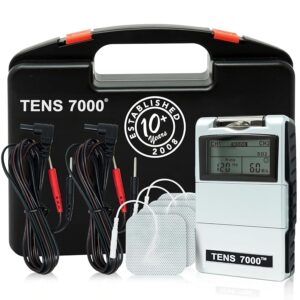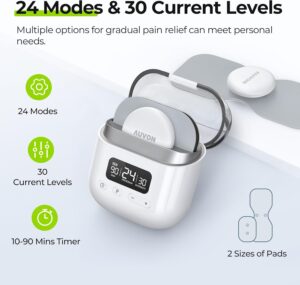Disclosure: This post has affiliate links, so I may earn a small commission (at no extra cost to you) if you shop through them. Thanks for your support!
Have you ever felt that nagging pain in your lower back that just won’t go away? If you’re looking for a way to find relief, a TENS (Transcutaneous Electrical Nerve Stimulation) unit might be just what you need. This device can help you manage pain effectively, all from the comfort of your home. Let’s unpack how to use a TENS unit for lower back pain effectively and make those days of discomfort a thing of the past.
What is a TENS Unit?
A TENS unit is a small, battery-operated device that sends electrical impulses through the skin to stimulate the nerves in a specific area of your body. While it may sound a bit odd at first, the sensation of the electrical pulses can block the pain signals sent to your brain, offering you temporary pain relief.
These devices are popular among those who suffer from chronic pain, including lower back pain, and are designed to be user-friendly, allowing you to take control of your pain management.
How Does a TENS Unit Work?
Understanding how a TENS unit operates can help you utilize it effectively. When you place the electrodes on your skin, the electrical impulses generated by the unit work in two primary ways:
- Blocking Pain Signals: The electrical impulses can interfere with the body’s ability to send pain signals to the brain, effectively blocking the pain you feel in your lower back.
- Stimulating Endorphin Release: Additionally, the stimulation can encourage the production of endorphins—natural pain-relieving hormones. This means that not only can you block pain signals, but you can also foster your body’s own healing mechanisms.
Benefits of Using a TENS Unit for Lower Back Pain
You might wonder why you should consider using a TENS unit. Here are some of the compelling benefits:
Non-Invasive Treatment
Using a TENS unit is a non-invasive way to manage pain. Unlike medications, which can come with side effects, a TENS unit doesn’t require any injections or surgeries. It gives you control over when and how you experience pain relief.
Portable and Convenient
TENS units are small and portable. This means that you can use them at home, at work, or even while you’re out and about. Whether you’re stuck at your desk or relaxing at home, you can easily set up your TENS unit to provide relief when you need it most.
Customizable Settings
Most TENS units come with adjustable settings for intensity and frequency, allowing you to tailor your treatment to your comfort level. Finding that sweet spot where you feel relief without discomfort is entirely possible.
Safe for Regular Use
A TENS unit can be used multiple times throughout the day as needed, making it a great option for managing chronic lower back pain without any significant risks or drawbacks.
Choosing the Right TENS Unit
When choosing a TENS unit, there are a few factors to consider. The right device can enhance your experience and offer better results.
Types of TENS Units
- Portable TENS Units: These are battery-operated and designed for easy mobility. They’re great for everyday use.
- Digital TENS Units: These come with programmable features and settings for a more customized experience. They typically have screens displaying settings.
- Combination Units: Some devices combine TENS with other therapies, such as muscle stimulation. These might offer broader therapeutic benefits.
Key Features to Look For
- Adjustable Intensity: Ensure the unit has various intensity settings to suit your comfort level.
- Pre-programmed Options: Look for units that offer pre-set modes for different types of pain or treatment areas.
- Rechargeable Battery: A rechargeable unit can save you money and hassle compared to one that requires regular battery replacements.
- Size and Portability: Consider the size of the unit if you plan to take it with you. A more compact model may be beneficial.
How to Use a TENS Unit for Lower Back Pain
Using a TENS unit is fairly straightforward, but you want to make sure you do it correctly for maximum benefit. Here’s a simple guide to get you started.
Step-by-Step Instructions
- Read the Manual: Always start by reading the user manual that comes with your TENS unit. This ensures you understand the specific functions and recommendations for your device.
- Prepare the Skin: Before placing the electrodes, ensure your skin is clean and dry. If necessary, shave any excessive hair in the area to enhance conductivity.
- Position the Electrodes: Place the electrode pads around the painful area of your lower back. A common placement is to use two pads, one on either side of the pain, but you can also try different placements depending on where you feel discomfort.
- Connect the Electrodes: Once the pads are in place, connect them to the TENS unit according to the instructions provided.
- Set the Intensity and Mode: Start with a low intensity to get accustomed to the feeling. Gradually increase the intensity until you feel a comfortable sensation (not painful). Experiment with the different modes to find what works best for you.
- Duration of Use: It’s typically recommended to use the TENS unit for about 15-30 minutes at a time. You can repeat this several times throughout the day as needed.
- After Use: Once you’re finished, turn off the device, remove the electrodes, and store it safely. Clean the pads with a damp cloth if necessary, and allow them to dry before covering.
Safety Precautions
While using a TENS unit is generally safe, keep these precautionary tips in mind:
- Consult Your Doctor: Always consult with a healthcare professional before using a TENS unit, particularly if you have underlying health conditions or are pregnant.
- Avoid Broken Skin: Never place electrodes on broken or irritated skin, as this could cause further complications.
- Don’t Use While Driving: The sensation of TENS may distract you; avoid using it while engaging in activities that require your full attention, like driving.
- Watch for Allergies: If you notice any skin irritation or allergic reactions, discontinue use and consult a healthcare provider.
Combining TENS with Other Therapies
To enhance the effectiveness of your TENS unit, consider combining its use with other therapies. This multi pronged approach may yield better results in managing your lower back pain.
Physical Therapy
Working with a physical therapist can help you target your lower back pain more effectively. They can offer therapeutic exercises and techniques tailored to your needs while integrating TENS for pain relief when necessary.
Exercise and Stretching
Regularly engaging in exercise and stretching can offer significant benefits for your lower back. TENS can complement this regimen by alleviating pain temporarily so you can engage in physical activity more comfortably.
Heat or Cold Therapy
Applying heat or cold therapy before or after using your TENS unit can help further minimize pain. Heat can relax muscles, while cold therapy can reduce inflammation. Experiment with the combination that feels best for you.
When to Seek Medical Help
Even with the use of a TENS unit, there are times when pain may persist or worsen, signaling a need for medical attention. Keep an eye out for the following signs:
- Severe Pain: If your pain is severe or increasing in intensity despite using the TENS unit, consult a healthcare provider.
- Neurological Symptoms: Any numbness, tingling, or weakness in your legs or feet should prompt a medical evaluation.
- Changes in Bladder or Bowel Function: These symptoms can indicate a more serious underlying issue and should be addressed promptly.
- Prolonged Symptoms: If you notice that your lower back pain does not improve over time or worsens, it might be time to revisit your healthcare provider for further investigation.
Final Thoughts on Using a TENS Unit
Incorporating a TENS unit into your routine can be a helpful and effective strategy for managing lower back pain. It’s a simple, non-invasive method that puts you in control of your pain relief journey. While you should always consult with a healthcare professional for prolonged pain, utilizing a TENS unit offers you comfort and convenience when you need it most.
Taking the time to understand how to use a TENS unit effectively can empower you to make informed choices about your pain management. Remember that relief might take time and experimentation, so be patient with yourself as you find the right approach. Your comfort and well-being are worth the effort.
Disclosure: This post has affiliate links, so I may earn a small commission (at no extra cost to you) if you shop through them. Thanks for your support!






